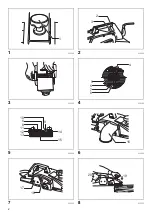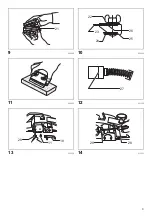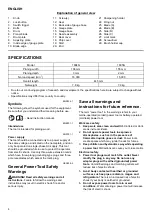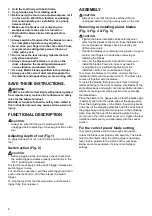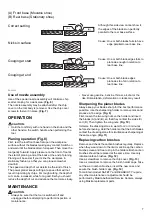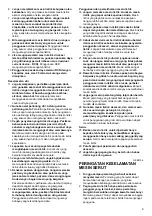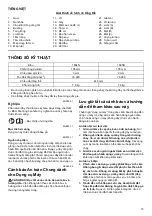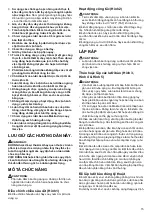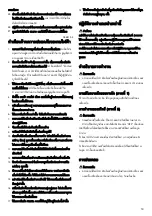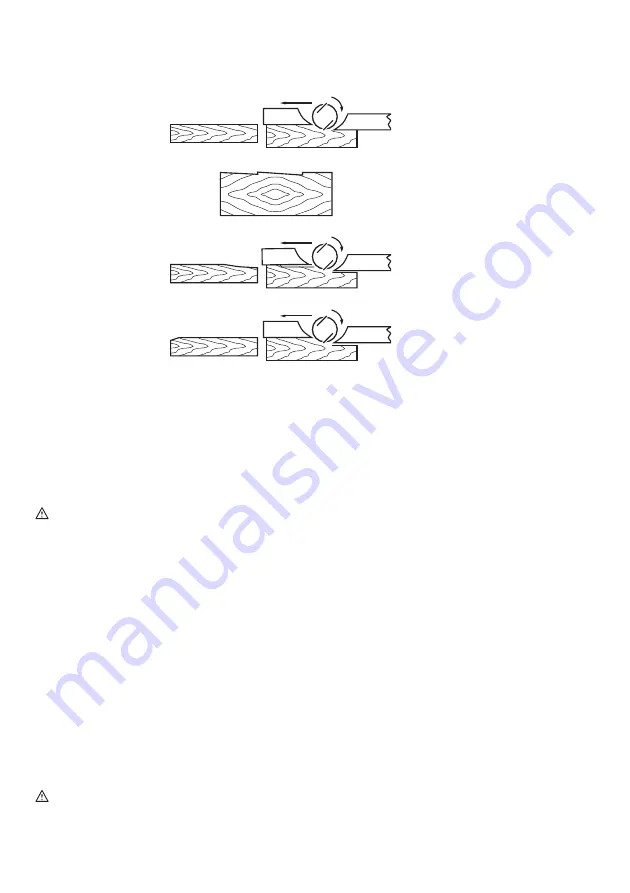
7
Use of nozzle assembly
Use of the special nozzle assembly will minimize chip
scatter, making for a work area.
(Fig. 6)
The nozzle assembly may be attached after the chip
cover on the tool body is removed. Use the chip cover
screws to fasten it in place.
(Fig. 7)
OPERATION
CAUTION:
• Hold the tool firmly with one hand on the knob and the
other hand on the switch handle when performing the
tool.
Planing operation (Fig. 8)
First, rest the tool front base flat upon the workpiece
surface without the blades making any contact. Switch on
and wait until the blades attain full speed. Then move the
tool gently forward. Apply pressure on the front of tool at
the start of planing, and at the back at the end of planing.
Planing will be easier if you incline the workpiece in
stationary fashion, so that you can plane somewhat
downhill.
The speed and depth of cut determine the kind of finish.
The power planer keeps cutting at a speed that will not
result in jamming by chips. For rough cutting, the depth of
cut can be increased, while for a good finish you should
reduce the depth of cut and advance the tool more slowly.
MAINTENANCE
CAUTION:
• Always be sure that the tool is switched off and
unplugged before attempting to perform inspection or
maintenance.
• Never use gasoline, benzine, thinner, alcohol or the
like. Discoloration, deformation or cracks may result.
Sharpening the planer blades
Always keep your blades sharp for the best performance
possible. Use the sharpening holder to remove nicks and
produce a fine edge.
(Fig. 9)
First, loosen the two wing nuts on the holder and insert
the blades (A) and (B), so that they contact the sides (C)
and (D). Then tighten the wing nuts.
(Fig. 10)
Immerse the dressing stone in water for 2 or 3 minutes
before sharpening. Hold the holder so that the both blades
contact the dressing stone for simultaneous sharpening at
the same angle.
(Fig. 11)
Replacing carbon brushes
Remove and check the carbon brushes regularly. Replace
when they wear down to the limit mark. Keep the carbon
brushes clean and free to slip in the holders. Both carbon
brushes should be replaced at the same time. Use only
identical carbon brushes.
(Fig. 12)
Use a screwdriver to remove the chip cover.
(Fig. 13)
Use a screwdriver to remove the brush holder caps. Take
out the worn carbon brushes, insert the new ones and
secure the brush holder caps.
(Fig. 14)
To maintain product SAFETY and RELIABILITY, repairs,
any other maintenance or adjustment should be
performed by Makita Authorized Service Centers, always
using Makita replacement parts.
(A) Front base (Movable shoe)
(B) Rear base (Stationary shoe)
Correct setting
Nicks in surface
Gouging at start
Gouging at end
Although this side view cannot show it,
the edges of the blades run perfectly
parallel to the rear base surface.
Cause: One or both blades fails to have
edge parallel to rear base line.
Cause: One or both blade edges fails to
protrude enough in relation to
rear base line.
Cause: One or both blade edges
protrudes too far in relation to
rear base line.
EN0004-1
(A)
(B)
(B)
(A)
(B)
(A)


